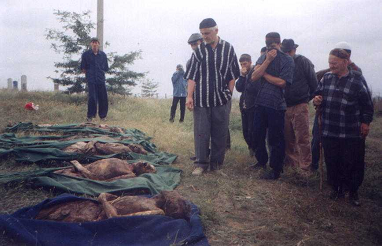Novye Aldy – before and after By Usam Baysayev, special to Prague Watchdog
Oslo, Norway
(A note by Prague Watchdog's coordinator of February 7: This material appeared on the Kavkaz-center website in violation of the reprint rules for our materials, and even without mentioning the names of the author and the translator).
The weather in early February 2000 was nasty, cold and grey. It was as if nature were responding to the horror of what was taking place and to the fear that was spilling over everywhere.
After their defence of Grozny the Chechen insurgents had fled to the mountains, leaving dead and wounded as they went. Now that Russia’s generals and politicians had tasted real victory they were almost impossible to stop.
The men who managed to escape from the combat zone no longer expected a quick end to the war. They were preparing to survive in terrible conditions, with an unpredictable future ahead of them. But the civilians who remained in Grozny and its suburbs tried not to look too far ahead. They lived for the present, and waited uneasily for what might come tomorrow. This went on for the next two months. For these people the departure of the Chechen forces meant a chance of survival – or at least that was how it seemed at the time.
On February 3 the bombardment of the city eased in intensity. By the following day it had subsided altogether. Russian military vehicles and armour began to appear in one district of the city and suburbs after another, at first tentatively, and then with growing confidence. Few were glad to see them, but they presented little threat. At least if the city were now under Russian control, people thought, there would be an end to the round-the-clock indiscriminate shelling. They wanted to believe that the worst of the trouble and danger was now over. In the village of Novye Aldy, just outside town, people started to mend their roofs, repair and patch up the walls and windows of their houses.
I will not describe the "mop-up" operation in the village, the number of people who were killed or the manner in which they met their deaths. All of that is explained in detail in the Memorial Human Rights Centre report. I will add only one correction: what Russia’s military did in Novye Aldy was nothing unusual or untypical. It did not represent the height of their brutality and judged by their normal standards it was not a supremely wicked act. Crimes no less terrible were committed in other parts of the city and the neighbouring villages. And they continued for much longer.
Even according to the most conservative estimates, during January 2000 several hundred people in Staropromyslovsky distict lost their lives at the hands of the security forces. They were not buried immediately, because there were cases when civilians were killed for doing just that. Many of the corpses were gnawed by animals and later collected and transported to the cemetery completely skeletonized and unidentifiable.
The events in Alkhan-Yurt and Starye Promysly were overshadowed by the battle for Grozny. People’s suffering there was drowned by the roar of the artillery. But the killings in Novye Aldy were done after that roar had ceased, and that is why their echo was so deafening.
After Novye Aldy Russia's security forces focused on counter-insurgency operations of the “roundup” type. Their principal characteristic was violence against a particular part of the population – males of fighting age. The operations were carefully planned and organized, leaving no doubt as to the awareness of the military commanders and the political leadership of what was going on. To all this were added hostage-taking, torture, looting, unlawful detention and killing, killing, killing.
Not even Novye Aldy brought an end to the slaughter.
Photo: "Memorial".
(Translation by DM) © 2010 Prague Watchdog (see Reprint info). (P,DM)
DISCUSSION FORUM
|

